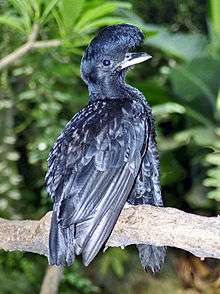Long-wattled umbrellabird
The long-wattled umbrellabird (Cephalopterus penduliger) is an Umbrellabird in the Cotinga family. Its common names include "Pájaro Bolsón", "Pájaro Toro", "Dungali" and "Vaca de Monte".[2] The Long-wattled Umbrellabird is considered rare and it resides in humid to wet premontane and cloud forest.[3] They are often found on the Pacific slopes of south-west Colombia and western Ecuador, but occasionally are found at lower altitudes.[3]
| Long-wattled umbrellabird | |
|---|---|
 | |
| Cephalopterus penduliger at Skansen, Stockholm | |
| Scientific classification | |
| Kingdom: | Animalia |
| Phylum: | Chordata |
| Class: | Aves |
| Order: | Passeriformes |
| Family: | Cotingidae |
| Genus: | Cephalopterus |
| Species: | C. penduliger |
| Binomial name | |
| Cephalopterus penduliger Sclater, 1859 | |
Description
The male is 40–42 cm in height, with the female being slightly smaller at 35–37 cm. Both sexes are short-tailed and carry an erectile head crest; that of the male is slightly longer at 20–30 cm. The male is distinguished by a large throat wattle of feathers, while females and juveniles have no or a much smaller wattle. The length of the wattle can be controlled, and it can be retracted in flight.[4] The male generally has black colored shafts in its feathers.[5]
The long-wattled umbrellabird's specific name penduliger derives from Latin "pendulus", hanging, and refers to the wattle.[6]
Distribution and habitat
The species shows a high level of endemism and is found from the southwestern part of Colombia to the province of El Oro in Ecuador, in the bioregion of Tumbes-Chocó-Magdalena.[2] It inhabits humid montane forests at 1,500-1,800 m above sea level on the ridges and sides of the Andes range.[2][5]
Ecology
Feeding
The species is mostly frugivorous and feeds on large fruit.[7] The fruits of Arecaceae, Lauraceae and Myrtaceae are preferred. Invertebrates and small vertebrates are also taken.[8][9][10]
Reproduction
The long-wattled umbrellabird engages in lek mating, where the males congregate in common areas (leks) for display, which are visited by the solitary females.[11] Females select a male with prominent secondary traits such as aggression and territorial behavior.[12] Nests are built in trees or treeferns, and have been recorded at heights of 4.5–5 m above ground.[1]
Clutch sizes in the genus Cephalopterus are generally low, and only one egg is laid per nesting attempt.[13] Incubation lasts 27 or 28 days. Only the female incubates and cares for the nestling. She provides food for the nestling on average once per hour and includes invertebrates, vertebrates and regurgitated material.[14]
Conservation
The species has been classified as Vulnerable by the IUCN. A total population of 6,000-15,000 mature individuals was estimated in 2012. It is thought to be under pressure from habitat destruction through deforestation and from hunting. The easy-to-locate lek mating areas make it particularly susceptible to trapping.[1]
The long-wattled umbrellabird is present in several protected areas. It has been suggested that the consolidation of existing scattered reserves, as well as the nomination of several existing protected areas as biosphere reserves, would be very beneficial for the species.[1] The curating of forest composition and reforestation have been pointed out as important approaches.[2]
References
- BirdLife International (2012). "Cephalopterus penduliger". IUCN Red List of Threatened Species. 2012.CS1 maint: ref=harv (link)
- Granizo, T; Pacheco, C; Ribadeneira, M.B; Guerrero, M; Suárez, L (2002). Libro Rojo de las Aves del Ecuador. Quito. pp. 177–178.
- Jahn, Olaf; Grefa, Edwin E. Vargas; Schuchmann, Karl-L. (March 1999). "The life history of the Long-wattled Umbrellabird Cephalopterus penduliger in the Andean foothills of north-west Ecuador: leks, behaviour, ecology and conservation". Bird Conservation International. 9 (1): 81–94. doi:10.1017/s0959270900003373. ISSN 0959-2709.
- Karubian, J.; Greeney, H. F.; Freile, J. F. (2010). "Long-wattled Umbrellabird (Cephalopterus penduliger)". Neotropical Birds Online. Ithaca: Cornell Lab of Ornithology.
- Ridgely, R.; Greenfield, P. (2006). Aves del Ecuador. Quito: Jocotoco.
- Granizo, T. (2009). Etimología: nombres científicos de las aves del Ecuador. Quito: Simbioe.
- Leck, C. (1979). "Avian Extinctions in an Isolated Tropical Wet-Forest Preserve, Ecuador". The Auk. 96 (2): 343–352. JSTOR 4085313.
- Snow, D. W. (1982). The Cotingas: bellbirds, umbrellabirds, and other species. Cornell University Presslocation=Ithaca, NY.
- Ridgely, R. S.; Greenfield, P. J. (2001). The birds of Ecuador. Ithaca, NY: Cornell University Press.
- Berg, K. S. (2000). "Field notes on the biology of the Long-wattled Umbrellabird Cephalopterus penduliger in west Ecuador". Cotinga. 14: 26–29.
- Karubian, J.; Durães, R.; Storey, J. L.; Smith, T. B. (2012). "Mating Behavior Drives Seed Dispersal by the Long-wattled Umbrellabird Cephalopterus penduliger". Biotropica. 44: 689–698. doi:10.1111/j.1744-7429.2012.00859.x.
- Andrade, G. (2010). Comportamiento y distribución del Pájaro Paraguas Longipéndulo Cephalopterus penduliger en el occidente del Ecuador (Thesis). Universidad San Francisco de Quito.
- Karubian, J.; Castañeda, G.; Freile, J.F.; Salazar, R.T.; Santander, T.; Smith, T.B. (2003). "Nesting biology of a female long-wattled umbrellabird Cephalopterus penduliger in north-western Ecuador". Bird Conservation International. 13: 351–360. doi:10.1017/s0959270903003253.
- Greeney, H.; Kirwan, M.; Miller, E. (2012). "Nesting biology of the Long-wattled Umbrellabird Cephalopterus penduliger. Part II: nestling provisioning". Cotinga. 34: 96–99.
External links
- A classification of the bird species of South America at Museum.lsu.edu
- Birdlife
- The Internet Bird Collections
- Arkive
- EoL
- Encyclopædia Britannica
| Wikimedia Commons has media related to Cephalopterus penduliger. |
